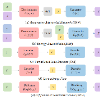Denoising diffusion models are a recent class of generative models which achieve state-of-the-art results in many domains such as unconditional image generation and text-to-speech tasks. They consist of a noising process destroying the data and a backward stage defined as the time-reversal of the noising diffusion. Building on their success, diffusion models have recently been extended to the Riemannian manifold setting. Yet, these Riemannian diffusion models require geodesics to be defined for all times. While this setting encompasses many important applications, it does not include manifolds defined via a set of inequality constraints, which are ubiquitous in many scientific domains such as robotics and protein design. In this work, we introduce two methods to bridge this gap. First, we design a noising process based on the logarithmic barrier metric induced by the inequality constraints. Second, we introduce a noising process based on the reflected Brownian motion. As existing diffusion model techniques cannot be applied in this setting, we derive new tools to define such models in our framework. We empirically demonstrate the applicability of our methods to a number of synthetic and real-world tasks, including the constrained conformational modelling of protein backbones and robotic arms.
翻译:噪声扩散模型是一种新近的生成模型类别,它在无条件图像生成和文本转语音等许多领域内实现了最先进的结果。它们由一个破坏数据的噪声过程和一个被定义为噪声扩散的时间反演构成。建立在它们的成功之上,扩散模型最近被扩展为黎曼流形环境。然而,这种黎曼扩散模型要求所有时刻定义测地线。虽然这个环境包括许多重要的应用,但它不包括通过一系列不等式约束定义的流形,这在许多科学领域如机器人和蛋白质设计中是普遍存在的。在这项工作中,我们介绍了两种方法来弥合这个差距。首先,我们设计了一种基于不等式约束诱导的对数障碍度量的噪声过程。其次,我们介绍了一种基于反射布朗运动的噪声过程。由于现有的扩散模型技术无法应用于这个环境中,因此我们开发了在我们的框架中定义这种模型的新工具。我们通过一些合成的和实际的任务来证明我们的方法的适用性,包括蛋白质骨架的约束构象建模和机器人臂的约束运动规划。



